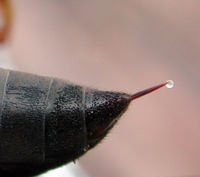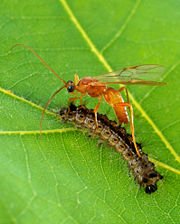|
Aleiodes indiscretus
parasitizing a gypsy moth caterpillar |
|
TRANSLATIONS
A painting will never be finished - unless it is a stilleben - 'a representation not of inanimate objects but of living things in a state of rest' (English Etymology). We must go on and leave the not finished painting of hua poporo. Inanimate objects do not exist, the concepts of 'object' and of 'inanimate' are false. 'Spirit' is everywhere and nothing is isolated. The western mind is one-eyed, cannot observe in depth. We must move focus from hua poporo to the ragi glyph type:
It is composed, it seems. from vero and in the background (below vero) the form of the (living) moon. Upside down 'moon canoe' means 'death':
Sun occupies 10 of the first 12 glyphs in line a1. Aa1-2 and (10 glyphs later) Aa1-12 belong to the moon. Aa1-2 is a living moon (showing growing phase), while Aa1-12 is the half-moon shape illustrating the 'dead canoe' (ihe tau). We can compare with Ca7-27, with the luminous part of the moon at the bottom, not as in ihe tau at the top:
Ihe tau glyphs always (or nearly so, cfr e.g. Nb5-105) seem to be drawn with the pointed end upwards. Therefore, we can assume the glyph type to be illustrating the waning of the sun. The waxing sun, we have noted, can be represented by a reversed ihe tau, though:
Adding 10 to the ordinal numbers in Aa1-3--4, we presumbly should be able to observe reversal:
Sun is running upwards in spring and downwards in autumn. Aa1-3--4 probably refers to the 1st 'year', not to autumn equinox time. The differences between the 1st and 2nd 'years' are so great as to make a reference in Aa1-4 to autumn equinox is out of the question. The action (life) in Aa1-3--4 is in Aa1-13--14 not visible, it is 'inside'. Life in the season of regeneration is not outside moving around, it is still on the outside in order to concentrate the efforts on the inside. If the 'insect' flits (oro) high above at 'noon', she must be in the larva (grub) phase before that; moving around and eating all the time. The journey begings even earlier though, because the larva in turn must have originated from an egg (hua), an egg for the development in the dark season (hua poporo). Maybe the vero, the 'harpoon', is the weapon used by the 'wasp' in order to give her offspring a good environment, in order to start their development. The 'a.m.' phase of an insect is a suitable 'host':
|
||||||||||||||||||||||||||||||||||||||||||||||||||||||||||||||||||||||||||||||||||||||||||||||||||||||













